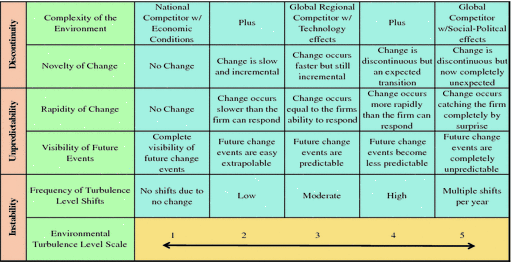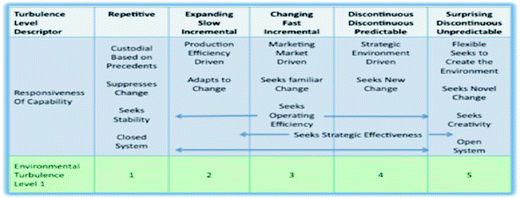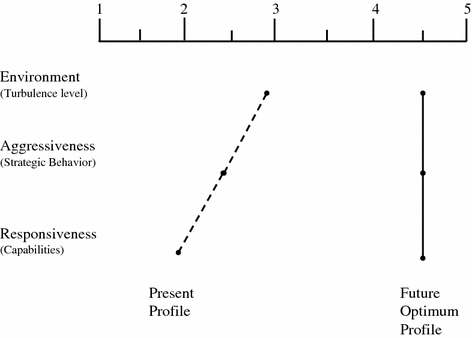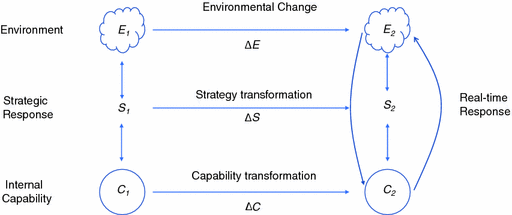In this chapter, Ansoff describes the consequences of the evolving challenges to management of the business firm. One important consequence is differentiation of challenges among firms. This means that the tradition of universal prescriptions for management of all firms must give way to a tailored approach in which each firm identifies its own future challenges and develops its own responses. The first step in this tailored approach is the strategic diagnosis which determines the nature of a firm’s strategic problem(s).
Two Key Problems for Strategic Management
Evolving environmental challenges surfaced in the USA during the mid-twentieth century: product-market shifts, developing nations, inadequacy of management capabilities, external sociopolitical pressures, and disruptive technology. Other developed countries arrived at the same challenges however their dates lagged by approximately fifteen years, Germany approximately ten years, Japan approximately twenty years.
By the 1980s, the challenges in the developed countries converged toward similar challenges. This convergence has been referred to as the common ‘postindustrial predicament’ of the developing nations.
- 1.
As they faced the 1990s, a small minority of industries still confronts an agenda very similar to that of the first quarter of the century. The key challenge in such industries is to continue satisfying a basic demand for undifferentiated, reliable, unchanging products within the limits of a national market. The cement and funeral industries are examples of this minority.
- 2.
A significant number of industries still confront the challenges of the second quarter of the century. Food processing, consumer durables, and low technology producer durables share the challenges of satisfying differentiated and continually changing needs of their customers.
- 3.
A majority of industries must still face one or both of the challenges of the first half century but also must confront new challenges of the 2000s. The new challenges are numerous, discontinuous, diverse, and complex.
Firms in such industries must:Continuously survey the environment for signs of future discontinuity and potential surprises.
Cope with rapid saturation of markets.
Respond to frequent changes in competitive structure and dynamics.
Take advantage of opportunities in new growth industries.
Anticipate threats of invasion of their industry by alien technology.
Respond to global competition.
Adapt to political upheavals.
Respond to social pressures on the firm.
Cope with government regulations of business behavior.
- 4.
A small (but growing) and important group of industries consists of the creators of economic and technological progress. These are the high-tech industries, born of novel technologies: nano-technologies, augmented technology, 3-D technology, six-core processors, solar fuel, atmospheric energy, etc. These are also new industries in the burgeoning service sector. Their challenge is to use leading-edge technologies to create products which serve previously unfilled needs of society, and thus create new industries.
- 1.
The continuing evolution of the change agenda makes it dangerous to base future plans on successful responses to historical challenges.
- 2.
There is no single prescription for future success which will apply to all firms.
- 1.
Each firm needs to diagnose its unique pattern of future challenges, threats, and opportunities.
- 2.
Each firm must design and implement its own unique response to these challenges.
This book is dedicated to enabling general management of a firm to develop unique, creative, thoughtful, and systematic solutions to these two problems.
Strategic Success Paradigm
Strategic diagnosis is a systematic approach to determining the changes that have to be made to a firm’s strategy and its internal capability in order to assure the firm’s success in its future environment.
The diagnostic procedure is derived from the strategic success paradigm, which has been validated by empirical research.
- 1.
Aggressiveness of the firm’s strategic behavior matches the turbulence of its environment.
- 2.
Responsiveness of the firm’s capability matches the aggressiveness of its strategy.
- 3.
The components of the firm’s capability must be supportive of one another.
In the following pages, Ansoff defines the concepts of environmental turbulence, strategic aggressiveness, and organizational responsiveness. (Management capability will be discussed in Chapter 7). We will next develop instruments by which turbulence, aggressiveness, and responsiveness can be estimated. Finally, we will describe a procedure for combining these assessments into a strategic diagnosis.
Environmental turbulence is a combined measure of the changeability and predictability of the firm’s environment. We will describe it by five characteristics in three categories: discontinuity, unpredictability , and instability.
- 1.
Complexity of the firm’s environment.
- 2.
Relative novelty of the successive challenges which the firm encounters in the environment.
- 1.
Rapidity of change, the ratio of the speed with which challenges evolve in the environment to the speed of the firm’s response.
- 2.
Visibility of the future which assesses the adequacy and the timeliness of information about the future.
Instability:
1. Frequency of turbulence level shifts in the industry.
Turbulence scale

A firm can confine its attention to its historical marketplace.
Successive challenges are a repetition of the past.
Change is slower than the firm’s ability to respond.
The future is expected to replicate the past.
Level 1 turbulence is rarely observable in the free market economies in which natural forces of competition are at work. The reason is that the key to success in today’s competitive environment is continual substitution of new products/services which are superior to the historical products/services. Firms which do not innovate do not survive.
While level 1 turbulence is rarely observable in a free market economy, the other levels, shown in Table 6.1, are all observable today. They have already been described (in order of increasing turbulence) by the five challenge agendas in this chapter (where they are numbered from 2 to 5 to correspond to the levels of turbulence). The turbulence scale can be used to diagnose the level of turbulence expected in the firm’s environment over the coming years.
As we shall show in the following pages, at level 4 and above, active concern with strategic management becomes vital to a firm’s success and, indeed, even its continued survival.
Strategic Aggressiveness
- 1.
The degree of discontinuity from the past of the firm’s new products/services, competitive environments, and marketing strategies. The scale of discontinuity ranges from no change to incremental change, to change which is discontinuous for the firm but observable in the environment, to creative change which has not been observed previously.
- 2.
Timeliness of introduction of the firm’s new products/services relative to new products/services which have appeared on the market. Timeliness ranges from reactive to anticipatory, to innovative, to creative.
Matching aggressiveness to turbulence
Turbulence level descriptor | Repetitive | Expanding Slow incremental | Changing fast incremental | Discontinuous Discontinuous Predictable | Surprising Discontinuous unpredictable |
|---|---|---|---|---|---|
Strategic aggressiveness | Stable Based on Precedents | Reactive Incremental based on experience | Anticipatory Incremental based on extrapolation | Entrepreneurial Discontinuous based on expected futures | Creative Discontinuous based on creativity |
Environmental turbulance level 1 | 1 | 2 | 3 | 4 | 5 |
As previously discussed, level 1 aggressiveness is rarely observed in the business environment, but it is common in the not-for-profit organizations which do not change their products/services unless forced by a threat to their survival.
At level 2, the environment changes slowly and incrementally, a firm succeeds if it changes its products only in response to competitors’ moves. In the absence of threats from competition, such firms stick to their historical products/services, while minimizing costs and underpricing competition. As discussed in the previous section, level 2 was typical of the business environment of the first part of the twentieth century.
At level 3, firms progressively improve their historical products/services in anticipation of the evolving needs of the customers. Firm’s that are able to discover the secret of shaping and influencing the customer’s wants capture a greater share of the market.
Successful firms on level 4 continuously scan their environment in order to identify future economic, competitive, technological, social, and political discontinuities.
The principle of ‘sticking to one’s knitting’ is replaced with ‘being where the action is.’ The firm stays in an industry only as long as it expects the prospects to be attractive and its own competitive position to remain viable. When an industry loses attractiveness, or the firm can no longer compete, it exits the industry in a timely manner.
The firm continually seeks and enters other industries in which the future looks bright and the firm can succeed.
Thus, the firm continually and with foresight moves its resources from markets and industries which will become unattractive into growing and profitable industries of the future.
In every industry in which it participates, the successful firm continually reassesses the competitive factors which will bring future success. Whenever the historical success strategies do not match the future success factors the firm either develops new strategies or leaves the industry.
The success formula on level 5 is straightforward: to remain a leader in developing products/services incorporating the cutting edge of innovation and technology.
To repeat the first part of the strategic success paradigm: to assure success, the aggressiveness level of the firm’s strategic behavior must match the turbulence level of the environment.
Responsiveness of the Firm’s Capability
In addition to strategic aggressiveness, the responsiveness of the firm’s organizational capability must also be matched to the environmental turbulence.
Matching responsiveness to turbulence

On level 2, the efficiency-driven firm permits strategic change to occur, but only after operating management has failed to meet the firm’s goals. The organization is introverted, focused on internal efficiency and productivity. Little attention is paid to the environment since it is assumed that minimization of cost will automatically assure success in the marketplace. The power center is usually in the production function. As a result, efficiency-driven firms are frequently referred to as production-driven.
Successful market-driven firms on level 3 are extroverted and future oriented. The focus is on serving the future needs of the firm’s historical customers, using the historical strengths of the firm. The word ‘our’ is frequently heard in such firms our products, our technology, our customers. The firm’s strategic planning is based on historical success strategies the marketing function typically drives the firm, hence the frequent use of the name market-driven to describe such firms.
A distinctive characteristic of an environment-driven firm on level 4 is that unlike the market-driven firm, it has no attachment to history. Future validity of historical success strategies is continually challenged and so is the future attractiveness of historically attractive markets.
Unlike in all other types of responsiveness, no single function guides the behavior of an environment-driven firm. Power over strategic activity is exercised by general managers who balance the contribution of the functional areas. This balance is determined by the nature of the future environmental challenges and not by political influence of a single function.
The environment-creating firms on level 5 have a feature in common with efficiency and market-driven firms: all three are usually driven by a single function. On level 4, this may be a creative market development function or a creative R&D department.
A characteristic which distinguishes an environment-creating firm from production or market-driven firms is its total commitment to creativity. The past is recognized only as something not to be repeated.
The lower section of Table 6.3 shows that the strategic activity (doing the right thing) and the operating activity (doing the thing right) compete for both resources and management attention at levels 3 and 4.
The last line in figure shows that on level 1 a successful organization is introverted and totally focused on internal problems. As the turbulence level rises, the organization becomes progressively extroverted.
*Strategic Diagnosis
- 1.
How to diagnose the future environmental challenges which will confront the firm? The answer to this question is diagnosis of future turbulence levels in the firm’s environment.
- 2.
How to determine the firm’s strategic response which will assure success? The answers to this question are diagnoses of strategic aggressiveness and the organizational responsiveness which will match the future turbulence.
- 1.
The first step is to segment the firm’s environment into distinct strategic business areas which are likely to be on different turbulence levels. (The process of strategic segmentation will be discussed in detail in Chapter 8.)
- 2.
The second step is to choose the time horizon for the turbulence diagnosis. This will vary from one strategic business area (SBA) to another. A useful time horizon is the lead time needed in the SBA to develop a new generation of products/services.
- 3.
The third step is to use Table 6.1 to identify the future level of turbulence for each business area.
- 4.
The fourth step is to repeat the procedure to determine the present turbulence level in each of the business areas.
- 5.
The fifth step is to identify the strategic aggressiveness (using Table 6.2) and the responsiveness of capability (using Table 6.3) which will be needed for success in the future.
- 6.
The sixth step is to identify the present aggressiveness and responsiveness of the firm.
- 7.
The final step is to construct the firm’s present and future turbulence–aggressiveness–responsiveness profiles.

Example of strategic diagnosis
The figure shows that the present level 3 turbulence will move to level 4.5 in the future.
The present aggressiveness and responsiveness are lagging behind the present turbulence suggesting that the firm is not a top competitor.
However, it is too late to fix the present deficiencies. The focus must be on the gap between the present and future aggressiveness and responsiveness.
The gaps in the example suggest that the firm faces a massive challenge of changing both its strategic behavior and its capability if it is to become a top competitor in the future.
During the past 40 years, several thousand managers around the world have been involved in executing the strategic diagnosis. The profiles illustrated in Fig. 6.1 are typical of a mediocre competitor. Leading competitors usually show a vertical line for the present profile. However, a majority of the participants, including managers of many leading international firms, showed a significant gap between the present and future profiles.
Short and Long Version of the Strategic Diagnosis
The strategic diagnosis discussed in the preceding section is a short version which determines whether a firm must change its historical strategic response in order to succeed in the future. But it offers no details of the changes which must be made in the firm’s aggressiveness and responsiveness.
Chapter 7 presents a more detailed long version of strategic diagnosis which identifies specific changes in the strategic response of the firm.
Thus, the short version can be used for a quick identification of whether the firm has a strategic alignment problem, while the long version can be used to develop specific programs to solve the problem.
Validation of the Strategic Success Paradigm
Matching triplets—aggressiveness and responsiveness with turbulence the optimize a firm’s ROI
Turbulence level descriptor | Repetitive | Expanding | Changing | Discontinuous | Surprising |
|---|---|---|---|---|---|
Stable | Reactive | Anticipatory | Entrepreneurial | Creative | |
Strategic aggressiveness | Change based on precedents | Change based on experience | Incremental change based on extrapolation | Discontinuous new strategies based on observable alternatives | Novel, strategies based on creativity |
Responsiveness of general management capabilities | Stability seeking | Efficiency seeking | Market driven | Environment driven | Environment creating |
Environmental turbulence levels | 1 | 2 | 3 | 4 | 5 |
Conceptual Map of the Book
Strategic diagnosis identifies whether a firm need to change its strategic behavior to assure success in the future environment.
If the diagnosis confirms the need, the next step is to select and execute specific actions which will bring the firm’s aggressiveness and responsiveness in line with the future environment. The rest of this book is devoted to discussing ways for making these decisions logically, systematically, and implementing them effectively.

Managing firm’s adaptation to environment
The adaptation starts with a forecast of future growth/profitability in each of the firm’s business areas and of the factors which will be key to success.
If the diagnosis predicts a change in the turbulence level, forecasting based on extrapolation of historical trends, which is commonly used in business firms, becomes invalid. It is necessary, therefore, to use non-extrapolative forecasting techniques. Furthermore, it is imperative to make the results of the new, unfamiliar forecasts acceptable to the key decision makers. This problem of strategic information is discussed later in the book.
The information is used to select the strategic response (S2 on the figure) which will assure the firm’s future success. In environments on level 4 and above, two types of response are found in today’s practice. The first is positioning response which uses strategic planning to select the portfolio of business areas in which the firm will participate, and to develop the competitive strategies it will pursue in each area. The positioning response is later is Part II of the book.
The second type of response is the real-time response, which uses a technique called strategic issue management, to identify potentially unforeseen strategic threats and opportunities, to estimate their impact on the firm, and to develop and execute timely responses. Real-time response is discussed in Part V.
To assure effective implementation, the firm also needs to design the capability (C2) which will enable it to initiate and support the new strategic responses. A firm has two different, complementary capabilities: management capability to identify, plan, and guide the strategic response; and functional capability to execute the response.
Management capability is discussed in Part III; functional capability is discussed later in Part II in conjunction with the positioning response.
The planned strategic response S2 and the capability design C2 must next be put into practice. Whenever the gap ΔC between the present and desired capability is discontinuous, implementation of change typically encounters organizational resistance. Part VI deals with the problems of diagnosing and managing resistance.
- 1.
Strategic diagnosis which identifies the need for a new strategic response.
- 2.
Strategic planning which determines the future strategic response.
- 3.
Organizational design which plans the future organizational capability.
- 4.
Change management which implements the response and capability plans.
Summary
The challenges of the postindustrial ere were first felt in the USA and then progressively arrive in other developed countries. The total challenge agenda for the 2000s is practically the same in these countries, but the parts of the challenge agenda confronted by different industries are different. As a result, it is no longer possible to devise a single prescription for response to the challenges which would apply to all industries and firms. Therefore, the first step in strategic management is to perform a strategic diagnosis which identifies the type of strategic aggressiveness and organizational responsiveness a particular firm needs to develop in order to meet the future challenges of its environment.
Exercises
- 1.
Using the procedure found in this chapter, identify: (a) the turbulence level five to seven years from now, (b) necessary future strategic aggressiveness, and (c) necessary future organizational responsiveness for firms which aspire to be among the leading competitors in each of the following industries: automotive, artificial intelligence, commercialized space travel, banking, retailing, medicine, and any other industry with which you may be familiar.
- 2.For each industry, identify the following characteristics of the firm which will produce the necessary responsiveness:
- a.
Profile of skills, talents, and risk propensity of the key managers.
- b.
Characteristics of the organizational structure.
- c.
Characteristics of the organizational culture.
- d.
Basis of rewards and incentives for managers.
- a.